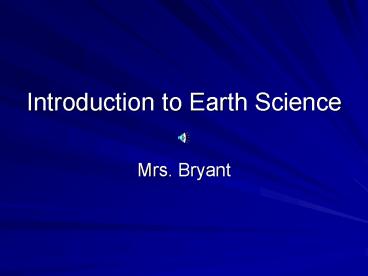Introduction to Earth Science - PowerPoint PPT Presentation
Title:
Introduction to Earth Science
Description:
Introduction to Earth Science Mrs. Bryant There are _____ major areas in Earth Science. _____ is the study of space. _____ is the study of the Earth s ... – PowerPoint PPT presentation
Number of Views:82
Avg rating:3.0/5.0
Title: Introduction to Earth Science
1
Introduction to Earth Science
- Mrs. Bryant
2
- There are _____ major areas in Earth Science.
__________ is the study of space. ____________ is
the study of the Earths atmosphere.
______________ is the study of the Earths
oceans. The study of Earths surface, materials,
and processes is ________.
four
Astronomy
Meteorolgy
Oceanography
Geology
3
Astronomy
- In astronomy we will study such topics as the sun
and other stars, planets and other objects in our
solar system, lunar phases, tides, and eclipses.
4
Meteorology
- Here we will take a look at cloud and
precipitation types, storms such as hurricanes
and tornadoes, and fronts, pressure systems, and
weather maps.
5
Oceanography
- We will explore our four major oceans, the
properties of seawater, ocean floor and coastline
features, ocean sediments, and major ocean
currents.
6
Geology
- Here we tackle a variety of topics including
minerals and rocks, volcanoes, earthquakes,
faults and folds, soils, erosion, mountains,
plate tectonics, and geologic history.
7
Earth Systems
- Although we study four branches of earth science,
there are many interactions between earths
systems. You are standing on the ______sphere.
You are breathing in part of the ______sphere.
If you went to the beach or canoed down the James
you where visiting the ______sphere. And you and
all the other living things on earth make up the
_____sphere.
litho
atmo
hydro
bio
8
Scientific Method
- When solving problems scientifically we follow a
series of steps to avoid wasting time, effort,
and resources. These steps include - 1. Defining the ________ (may include research or
observation) - 2. Research the problem or question. What has
been done already? - 3. Stating a ____________ (explanation of
observation must be able to be tested) - 4. _________ the hypothesis (involves measurement
of one variable at a time) - 5. Analyzing the _________ (data organized in
graphs, tables, and charts) - 6. Drawing _____________ (returning to step 2 as
needed) - This is not a rigid, step-by-step outline.
problem
hypothesis
Testing
results
conclusions
9
What are the Steps in Scientific Method?
10
Vocabulary
- ________- the standard for comparison in an
experiment. - _______- all the variables we are not
- testing and trying to keep the same
- ___________________- factor in an experiment that
may change if the independent variable changes,
the dependent variable is what is measured - _____________________- factor that the
experimenter changes
Control
Constants
Dependent Variable
Independent Variable
11
- A student formulated a hypothesis that cotton
will grow larger bolls (pods) if magnesium is
added to the soil. The student has two
experimental fields of cotton, one with magnesium
and one without.
12
What is the independent variable in the
experiment
- magnesium
13
What is the control in the experiment?
- The group grown without magnesium.
14
What are possible constants in the experiment?
- Amount of water, soil, sunlight.
- Type of Soil
- Temperature
15
What would be a possible dependent variable in
the experiment?
- Pod Size































